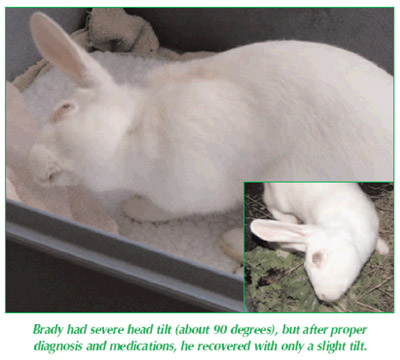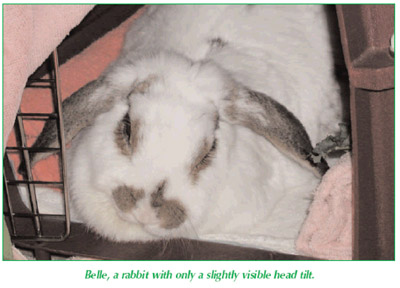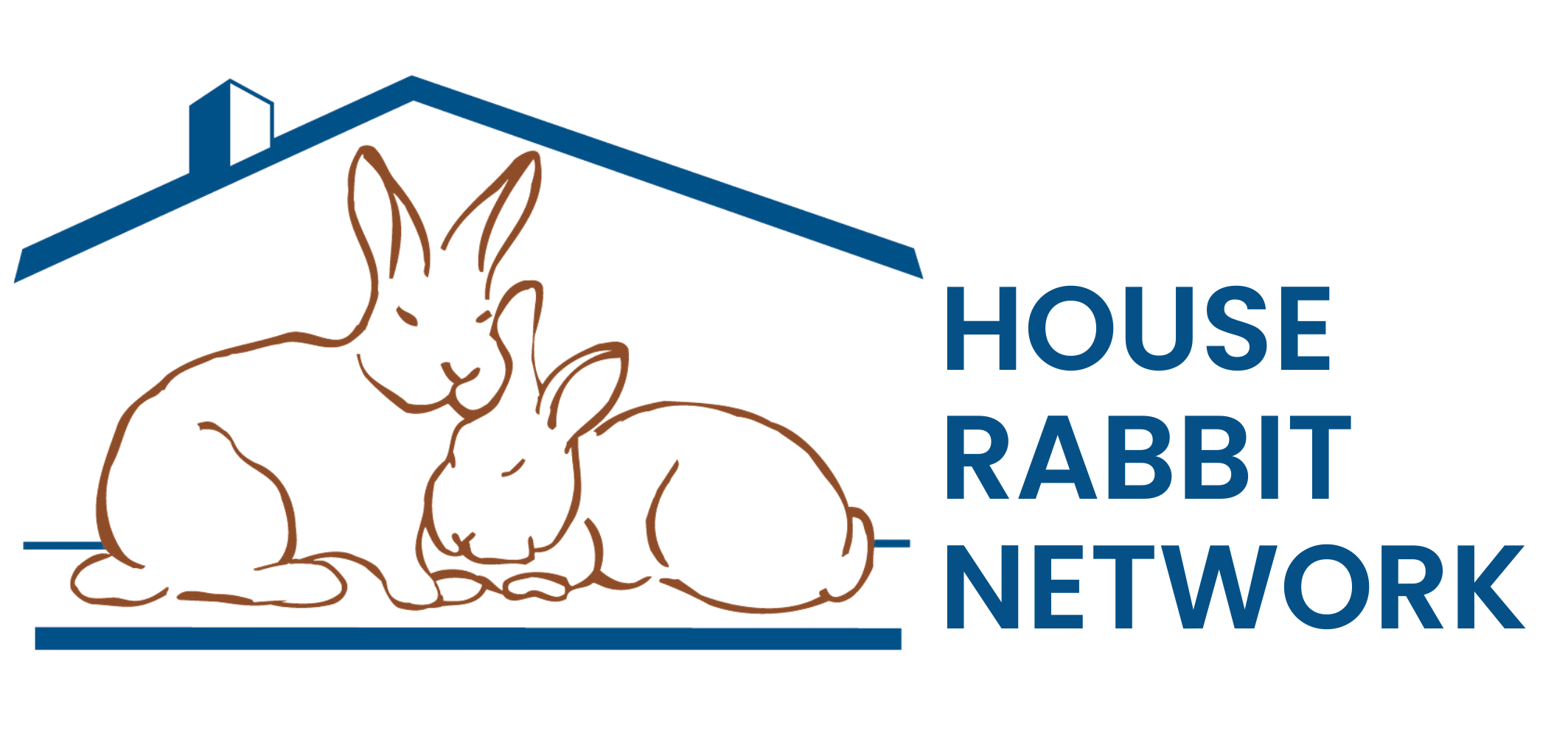Head Tilt in Rabbits

Head tilt in rabbits, also referred to as torticollis or wry neck, is an indicator of vestibular disease. The vestibular system is a neurologic system that controls balance and coordination. In rabbits, head tilt can be subtle, or it may seem as though a rabbit’s head is turned upside-down. Rabbits may appear unsteady, have involuntary back and forth eye movements called nystagmus, or even walk in circles and fall over because of problems with balance. The vestibular system has two parts: (1) nerves in the inner ear (peripheral vestibular system), and (2) nerves in the brain stem (central vestibular system). Knowing where the disease is can help a veterinarian figure out what is causing the disease, and how best to treat it.
Peripheral vestibular disease is usually associated with an inner ear infection. Although many bacterial infections can occur in rabbits, one of the more common causes of head tilt in rabbits is a bacterial infection called Pasteurella (snuffles). Pasteurella can spread from the nose to the inner ear through the Eustachian tube. Rabbits with inner ear infections are usually alert and strong.
A second common cause of head tilt in rabbits is Encephalitozoon cuniculi, also known as E. cuniculi. E. cuniculi is a microscopic parasite that usually affects nervous tissue, the lens of the eyes, and the kidneys. Rabbits can become infected through exposure from the urine of infected animals or through the placenta.
Rabbits can harbor the organism in their bodies for years without showing any signs of illness. When a rabbit is stressed and his or her resistance is diminished, signs of the disease can appear to come on suddenly. Occasionally, even common stressors like veterinary visits or spay/neuter surgeries can be enough to precipitate the disease. E. cuniculi infections are usually associated with central vestibular disease in rabbits. Like rabbits with inner ear infections, these rabbits can have head tilt, a loss of balance, and nystagmus. Unlike rabbits with ear infections, rabbits with E. cuniculi may be depressed, may show signs of weakness, and may not be able to sense where the feet and legs are, or be able to return them to a normal position.
Veterinarians depend on history and physical exam findings to help determine whether the disease is peripheral or central. If there is a history of an upper respiratory infection or visible discharge in the ear, a diagnosis of Pasteurella may be more likely. However, unless the patient’s tympanic membrane is ruptured, inner ear infections are generally not visible and cannot be diagnosed by simply looking in the patient’s ear. Because of their location, these infections are difficult to culture, so it is not always possible to figure out which bacteria is responsible for the disease. There are blood tests available for Pasteurella and E. cuniculi, but they cannot differentiate between rabbits that have been exposed and rabbits that are actively infected. Radiographs (x-rays) can sometimes show changes if there is a chronic ear infection. When accessible, the most accurate diagnosis is with a CT or MRI scan.
If an inner ear infection is suspected, a rabbit may be started on a course of antibiotics. Since these infections are difficult to culture, a broad-spectrum antibiotic that is safe for rabbits is usually administered for several weeks. A cure is difficult to obtain, and many rabbits require long term or recurrent antibiotic therapy.

E. cuniculi infections are most commonly treated with a dewormer called panacur, or fenbendazole. This medication is usually given once daily for a month. Panacur is relatively inexpensive and has few side effects, unlike other medications (such as albendazole) which have been associated with a number of complications. Many rabbits with head tilts caused by E. cuniculi do get better on their own, without treatment. However, some rabbits require more aggressive treatment. Because the symptoms of E. cuniculi occur when cells rupture and produce inflammation, anti-inflammatory medications are often used. Nonsteroidal inflammatory drugs such as metacam (meloxicam) are commonly used in rabbits. Corticosteroids are much more controversial, but can be beneficial when used short-term in rabbits with E. cuniculi infections.
The use of anti-nausea drugs is also controversial. We do know that dogs and people with vestibular disease are nauseous, and often vomit. Since rabbits do not vomit, it is more difficult to determine if they experience nausea. Drugs such as diphenhydramine (benadryl) and meclizine (bonine) are over-the-counter medications which are sometimes used in rabbits with severe vestibular disease. Their effectiveness is still unknown.
One of the biggest challenges with vestibular rabbits is helping them navigate in their environment. Rabbits with head tilts and balance problems may have difficulty getting to food and water and are more prone to injury from stumbling and falling. Nutritional support is critical in rabbits that are not eating on their own. This might involve supporting the rabbit in an upright position and holding its food, or syringe feeding formulas such as Critical Care for Herbivores. Cage modification is also important and rabbits should be restricted to one level and be offered padding to minimize risk of injury. Litterboxes may also need to be adapted, since rabbits with balance problems can have difficulty hopping in and out of a standard litterbox. A rabbit should be allowed to engage in as much supervised normal activity as possible, since exercise helps a rabbit’s nervous system compensate for vestibular disorders.
Alternative therapies, including acupuncture and physical therapy, are sometimes employed and may be beneficial. These treatment modalities are becoming more common in veterinary medicine, though it is unknown whether they affect a rabbit’s longterm prognosis.
The prognosis for a rabbit with a head tilt is variable and difficult to predict. Rabbits that are depressed and are not eating generally don’t do as well, and euthanasia may have to be considered in rabbits that continue to decline. The prognosis is better for rabbits with mild signs, and in fact some of these rabbits get better on their own. Many rabbits do respond to the treatment protocols that are offered, though some are left with residual head tilts. It takes time and commitment for a rabbit to improve, but many rabbits can go on to live relatively normal lives.
by Jacqueline Warner, DVM
